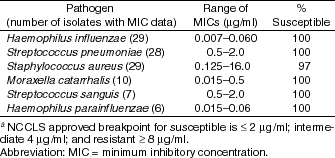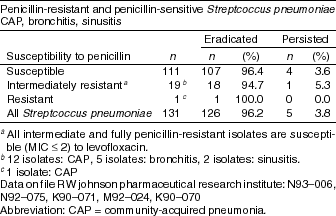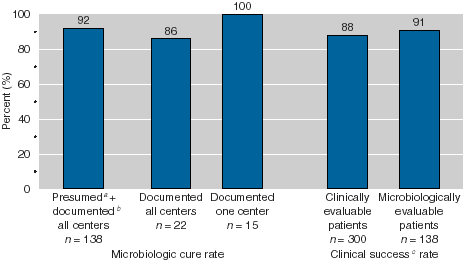Levofloxacin -- An Extremely Useful Drug in the Treatment of Sinusitis
President of the Virginia Medical Studies Group,
Charlottesville, USA.

The efficacy and safety of ofloxacin has been reported throughout the world for the treatment of a wide range of important infections. Levofloxacin, the l-isomer of the racemic ofloxacin, has been shown to be at least twice as effective as ofloxacin, while at the same time maintaining the excellent safety profile of its parent compound. Excellent pharmacokinetics with high levels of penetration into tissues throughout the body, coupled with a wide antibacterial spectrum and the ability to use a once-daily dosing schedule are all part of the levofloxacin profile. These advantages have been rapidly recognised by many physicians involved in the treatment of diverse infectious diseases, leading to levofloxacin becoming one of the most promising of the new fluoroquinolones to be put on the market.
To investigate the role of levofloxacin in the treatment of sinusitis, Penetration interviewed Dr. Thomas Austin Sydnor, President of the Virginia Medical Studies Group, Charlottesville, Virginia. Dr. Sydnor drew on his long clinical experience as well as research activities to review the use of levofloxacin in the treatment of sinus infections. Reporting on the results from a nationwide multicenter study, Dr. Sydnor confirmed that levofloxacin is an excellent therapeutic choice in community-acquired sinusitis, and that its judicious use can only continue to expand, with the introduction of this compound being of benefit to both the patient and physician.
![]()
Questions
Q6. Could you discuss chronic sinusitis, and how the treatment of this differs from acute disease?
Q7. What is the role of levofloxacin in treating other concomitant upper and lower RTIs?
Q10. How did you assess response in your study?
Q11. Could you discuss the results of your study?
Q12. Did you encounter any problems with adverse effects?
Q13. Did you look at compliance in these patients taking levofloxacin?
Q15. What about resistance in your population?
Q16. What are the areas of future research that you feel need to be particularly addressed?
![]()
Answers
Q1. Could you please comment on the pharmacokinetic and pharmacodynamic features of levofloxacin that make it a useful drug in sinusitis?
A1. Levofloxacin has many important advantages based upon its pharmacological profile. These include the fact that it can be given as an oral compound, using a once-daily administration schedule. It is rapidly absorbed via the gastrointestinal tract and penetrates very rapidly into tissues where it achieves a high concentration, even higher than in the plasma (1). Levofloxacin has a plasma half life of six to seven hours confirming its use as a once-daily medication. An important feature for many clinicians dealing with respiratory tract infections (RTIs), both upper and lower, is that levofloxacin has no drug-drug interaction with theophylline. In the patient population presenting with sinusitis, many of whom have co-existing problems such as chronic obstructive pulmonary disease (COPD) and are using theophylline, this provides a very useful and safe advantage. In addition, the uptake of levofloxacin is not inhibited by methylprednisolone, allowing it to be given to patients receiving steroids making it even more advantageous in this setting.
Q2. What are the main pathogens involved in acute sinusitis and how does this relate to the antibacterial spectrum of levofloxacin?
A2. The relative incidences of bacterial pathogens causing acute sinusitis has been well documented over the last 40 years throughout the world (Table 1). Streptococcus pneumoniae is recognised as causing about 31% of the adult maxillary sinus infections from cases with positive cultures (2, 3). Another 21% are attributable to unencapsulated Haemophilus influenzae and then a mixture of S. pneumoniae and H. influenzae account for approximately 5%. Anaerobes have been identified in 6% of cases, Staphylococcus aureus in 4%, Streptococcus pyogenes in 2%, Moraxella catarrhalis in approximately 2% and then mixed Gram-positive streptococci and Gram-negatives in about 9%. These percentages have been shown to be very consistent in most studies, with no major regional differences. These pathogens are those identified from the maxillary sinus and it is not known if there are differences between pathogens involved in other sinuses. This is due to difficulties in isolation of bacteria from other sinuses. It is much easier to get a definitive culture from the maxillary antrum because it acts as a closed space. Pathogens obtained from nasal cultures are similar, although in an individual case it is possible to have one organism in the nose and another in the maxillary antrum. Levofloxacin is very good in this setting as it is effective against all of the major pathogens, S. pneumoniae, H. influenzae, M. catarrhalis and S. aureus (Table 2) (1, 4).
Table 1. Bacterial etiologic agents in acute sinusitis (reference 3)
Table 2. Summary of minimum inhibitory concentrations (MICs) of levofloxacina for most prevalent (n ≥ 5) pathogens (reference 8)
In regard to its bacteriological strong points it possesses an excellent broad antibacterial spectrum with better Gram-positive coverage than previous fluoroquinolones, and is much better than ciprofloxacin in this regard. In addition, it covers the majority of bacteria that cause most upper RTIs. Levofloxacin is probably two to fourfold more active against staphylococci and streptococci than ciprofloxacin (1, 4).
Q3. What do you see as the major advantages that levofloxacin offers in comparison to other antimicrobials, including other fluoroquinolones?
A3. Levofloxacin is effective and safe and can be given orally once-daily. It covers the pathogens that are involved in sinusitis, and an added advantage is that it is effective in attacking organisms that are becoming resistant, a factor which is particularly relevant with the emergence of resistant S. pneumoniae, as well as ß-lactam and macrolide resistant organisms.
Q4. Could you comment on what many physicians report as an increasing incidence of resistance to commonly used antibacterial agents?
A4. Resistance certainly is a concern. In the Charlottesville region about 50% of the S. pneumoniae isolates at the University Hospital are of intermediate resistance to penicillin, and in the community hospital this figure has been reported as approximately 25%. These are not sinus cultures but are from pneumonia, acute exacerbations of chronic bronchitis, meningitis and so on. The susceptibility of penicillin-susceptible and -resistant S. pneumoniae to various antibiotics is outlined in Table 3. Levofloxacin is very good in this regard, achieving excellent microbiologic eradication rates against penicillin-resistant and penicillin-sensitive S. pneumoniae (Table 4). I am sure that we shall see a continuing rise in the incidence of resistant organisms, especially during the next winter. In similar studies we have performed previously looking at sinusitis we had a similar experience with ß-lactamase producing H. influenzae and M. catarrhalis. That is, up until 1985 we found no cases with ß-lactamase production but beginning in 1985 about 50% of the H. influenzae and M. catarrhalis were ß-lactamase producers and were therefore resistant to ampicillin or amoxicillin (2, 3).
Table 3. Susceptibility of penicillin-susceptible and -resistant Streptcoccus pneumoniae to various antibiotics (reference 6)a
Table 4. Microbiologic eradication rates after levofloxacin therapy
Q5. What is the role of levofloxacin for treating patients with sinusitis who are immunocompromised, either with HIV infection or due to alcoholism?
A5. Immunocompromised patients, with their impaired host defences, are dependent on antibiotic bactericidal activity, an advantage offered by levofloxacin with its essentially equivalent minimum bactericidal concentration (MBC) and minimum inhibitory concentration (MIC) levels for most pathogens. AIDS patients with sinusitis historically have the same organisms as those identified in acute adult sinusitis, plus a fair number of Gram-negative organisms, where the fluoroquinolones have been particularly good. In addition levofloxacin does not interact with the antiviral medications such as zidovudine often used in these patients. Although there is no specific data available, I am sure that levofloxacin would also be useful in transplant patients.
Q6. Could you discuss chronic sinusitis, and how the treatment of this differs from acute disease?
A6. Chronic sinusitis is a fairly poorly defined entity with no definite diagnostic criteria. Usually the diagnosis is made dependent on the time frame of infection. I personally believe that acute sinusitis is typically of a viral and bacterial etiology. In contrast chronic sinusitis is more of a mucosal disease, often with obstruction and the environment can certainly play a role. Therefore in chronic sinusitis while antibiotics play a significant part of the treatment regimen, in addition other modalities need to be instituted to provide optimum care. These include factors such as promoting drainage, improving humidity, and relieving any obstruction which may be present. Levofloxacin would have a significant role as the appropriate antibacterial therapy in chronic sinusitis. There has been a classification made of chronic sinusitis by Dr. Gwaltney, which divides this disease into three useful treatment categories (5). First, an acute exacerbation of chronic sinusitis, which is similar to an acute exacerbation of chronic bronchitis, with the predominant organisms being S. pneumoniae, H. influenzae, M. catarrhalis and some S. aureus. Second, there is the situation of chronic sinusitis which is becoming much more common following sinus surgery and in cystic fibrosis patients. The pathogens involved in this situation are S. aureus and P. aeruginosa, and relates to the development of crusts and very thick secretions. The third category includes infections caused by mixed diptheroids, mixed staphylococci and streptococci. It is very important in chronic sinusitis to get a culture to establish exactly which organism is involved, but levofloxacin does cover all of these pathogens.
Q7. What is the role of levofloxacin in treating other concomitant upper and lower RTIs?
A7. I believe levofloxacin is excellent in treating many RTIs, including both upper and lower tract infections. Studies of acute exacerbations of chronic bronchitis have shown levofloxacin to be very useful. The common lower RTIs have predominantly the same organisms that we talked about for acute sinusitis, but in addition there is Chlamydia pneumoniae, Mycoplasma pneumoniae, and Legionella spp. Levofloxacin is very useful in this setting, with its broad coverage making it an excellent choice in the treatment of all of these infections (6, 7).
Q8. Do you see a problem with inappropriate prescribing of antibiotics before they are needed for sinusitis. If so, when a patient presents to you how do you decide when, or if, to prescribe antibiotics?
A8. Absolutely, this is a major concern. There is tremendous public pressure to treat what we think is the common cold with an antibiotic. The decision of when to initiate antibiotic therapy can be difficult and depends on the time frame. If a patient has only two to three days, of nasal clear discharge, no fever, I would not prescribe antibiotics, but if over a weeks duration, classically described by the patient as a cold that just won’t go away, then it is more likely bacterial. I would prescribe an antibiotic sooner in those patients with co-existing chronic respiratory problems such as emphysema. By using judicious and well thought out prescribing habits the physician will ensure that excellent new drugs such as levofloxacin will be useful in a wide range of clinical situations for many years.
Q9. Could you describe the trial that you performed investigating levofloxacin in the treatment of sinusitis?
A9. This was a multi-center study which enrolled 329 patients throughout the United States (107 from the Virginia Group) (8). Patient characteristics were similar for all subjects enrolled in the study. We assessed adults with symptoms of less than four weeks duration, who presented with typical symptoms and signs such as nasal obstruction, purulent nasal discharge, facial discomfort, cough and headache. After obtaining informed consent we followed the trial protocol. Patients were given a sinus X-ray, and were enrolled into the study if this was judged to be positive (defined as the presence of opacity, air-fluid levels, or mucosal thickening of more than 6 mm). The aim of the study was to evaluate the safety and efficacy of levofloxacin in treating acute sinusitis in adults. After enrolment the patients had their antral sinus punctured and aspirated. The technique for this included first using a nasal decongestant before entering the antrum through the inferior meatus of the nose, and puncturing the medial wall of the antral sinus after using a topical anaesthetic and antibacterial. The material in the sinus was then aspirated directly into a syringe, or if necessary 2-4 ml of sterile saline was injected and then aspirated. This was then sent directly to the laboratory for cultures and sensitivity. The patient was then given levofloxacin 500 mg once-daily for ten days without regard to meals. Patients were asked not to take concomitant antacids within two hours of the levofloxacin. We did not use a higher dosage as we were bound by the protocol and levofloxacin was only given for ten days although the protocol allowed 10-14 days of treatment.
Q10. How did you assess response in your study?
A10. Our assessment included both pre- and post-therapy cultures, evaluation of post-therapy symptom improvement and X-ray changes. Patients were contacted by phone on day three to five to check progress and monitor for the development of any adverse events. They were then seen from three to seven days post-therapy at which time clinical signs and symptoms were re-evaluated and a repeat X-ray performed. Patients who were not clear radiographically at three to five days post-therapy were then brought back for long-term follow-up which was three weeks after cessation of therapy. All other subjects were called at that time, and those with symptomatic relapse, even if they had been judged as cured at their first post-therapy evaluation, were asked to return to be re-checked. In the multicenter study, bacterial eradication was said to have occurred if the symptoms and signs had improved and the X-ray was clear, although this was not proven conclusively by repeat cultures. In contrast, in our group we preferred to repuncture and reaspirate all patients who had produced a positive culture on enrolling into the study. Therefore in our study there is a much higher post-therapy bacteriological cure rate using post-therapy punct puncture and culture as opposed to clinical and radiographic evaluation.
Q11. Could you discuss the results of your study?
A11. In our group which included data from five sites in Virginia, we found 48 pathogens in 40 patients. Efficacy results are summarised in Figure. Looking specifically at changes from pre- to post-therapy cultures showed that using levofloxacin we achieved a 100% eradication rate. In the clinical response at three to five days post-therapy, only 74% were called cured, 18% were improved and 8% failed, yet 100% of the bacteria were eradicated. We found that many of those patients judged as failed did not have positive bacterial cultures. At the late post-therapy assessment, 92% were clinically cured and those with negative post-therapy cultures did not have any relapse.
Figure. Summary of efficacy results: microbiologic and clinical response at two to five days post-therapy (reference 8)
a Presumed eradication based on clinical response of cured or improved (microbiologically evaluable patients).
b Documented eradication based on posttherapy culture results (microbiologically evaluable patients).
c Clinical success = clinical outcome of cured or improved.
Q12. Did you encounter any problems with adverse effects?
A12. Side effects have been very minimal (8). In fact the safety of ofloxacin has already been well established, and as levofloxacin is as active as ofloxacin at half the dosage it was expected to be even safer. We found no problems even in those patients potentially more at risk, such as elderly or alcoholic patients. The incidence of adverse effects was very low in the nationwide study as well, out of the 329 patients only six (1.8%) discontinued due to adverse effects, three of which were skin related and the other three due to gastrointestinal effects. This discontinuation rate is very low compared to many antibiotics. The incidence of minor side effects was also minimal (4% dizziness and insomnia, although none of the central nervous system (CNS) effects encountered were serious). In our group of 107 we had only one discontinuation due to abdominal cramps. Levofloxacin was very safe and much safer than the macrolides, compared to the gastrointestinal effects encountered when using erythromycin and amoxicillin-clavulanate. Although a theoretical risk, we had no patients with phototoxicity.
Q13. Did you look at compliance in these patients taking levofloxacin?
A13. We assessed compliance using a daily sheet on which the patient marked down the time the took the medicine and also checked this by asking them to bring back their bottle of tablets. We found that we had excellent compliance with this once-daily levofloxacin schedule.
Q14. From your use of levofloxacin in this setting, what ENT infections would you recommend it be used for?
A14. Levofloxacin is an excellent drug for acute sinusitis and otitis media in adults. If this compound can be shown to be safe in children, I believe it would be of tremendous use in treating pediatric RTIs. Lower RTIs can also be treated using levofloxacin, as well as laryngotracheitis because of its good H. influenzaecoverage.
Q15. What about resistance in your population?
A15. We had no resistance in our study population but regional differences in resistance are very notable and the resistance of S. pneumoniae is becoming more prominent in certain areas. If resistant S. pneumoniae becomes a problem in this community, which I think it will, then levofloxacin would have a major role to play. Multidrug resistance would also be a concern, and the potential is there for levofloxacin to be very beneficial in this setting. It is also good to know that levofloxacin, like ofloxacin before it has good penetration into CNS in those cases in whom the physician may be concerned about meningitis.
Q16. What are the areas of future research that you feel need to be particularly addressed?
A16. Cost-effectiveness studies are needed, as physicians are coming under more and more cost containment pressures (9). I would also like to see more studies investigating the use of levofloxacin in the pediatric setting. Children present with many ear, nose and throat infections, as well as those of the upper and lower respiratory tract, and levofloxacin, if proven to be safe would be a tremendous drug for treating this patient population.
![]()
References
- Davis R, Bryson HM. Levofloxacin. a review of its antibacterial activitiy, pharmacokinetics and therapeutic efficacy. Drugs 1994; 47: 677-700.
- Gwaltney Jr JM, Scheld WM, Sande MA, Sydnor A. The microbiological etiology and antimicrobial therapy of adults with acute community-acquired sinusitis. a fifteen-year experience at the University of Virginia and review of other selected stidies. J Allergy Clin Immunol 1992; 90 (3 pt. 2): 457-62.
- Gwaltney Jr JM. State of the art: acute community-acquired sinusitis. Clin Infect Dis 1996; In press.
- Gootz TD, McGuirk PR. New quinolones in development. Expert Opin Invest Drugs (UK) 1994; 3: 93-114.
- Sydnor TA. Personal communication.
- Doern GV, Brueggemann A, Holley Jr HP, Rauch AM. Antimicrobial resistance of Streptococcus pneumoniaerecovered from outpatients in the United States during the winter months of 1994 to 1995: results of a 30-center National Surveillance Study. Antimicrob Agents Chemother 1996; 40: 1208-13.
- Andriole VT. The future of the quinolones. Drugs 1993; 46 (Suppl 3): 1-7.
- Sydnor A, Kopp E, Anthony K, LoCoco J, Kim S, Fowler C. An open-label assessment of the activity of levofloxacin for the treatment of acute community-acquired bacterial sinusitis in adults; American College of Asthma, Allergy and Immunology. Boston, 1996.
- Consensus Conference. Respiratory Infections in the Year 2000. Amelia Island, In press.















